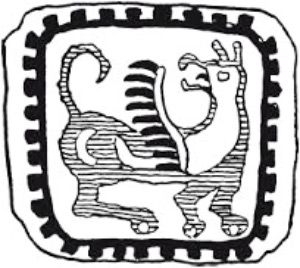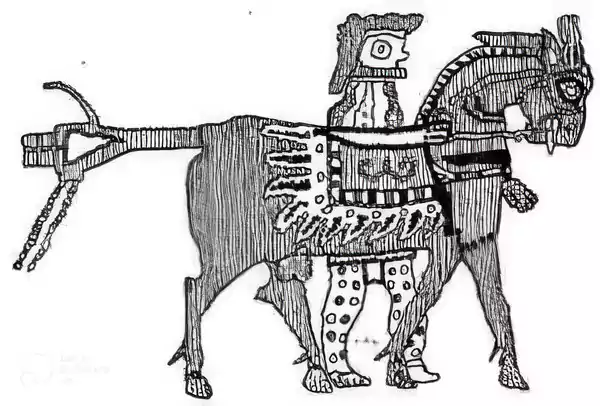- Abe
- Rug & Carpet
- 3305 views
- 0 comments
The Pazyryk Rug, or Pazyryk Carpet, is the oldest carpet in the world. Only a few carpet weavers have heard of it. Pazyryk rug can be considered a symbol of the history of carpet weaving and handmade carpets, which were discovered in Russia and revealed many ambiguities regarding their antiquity.
But there are many questions about this rug, whether it is an Iranian rug or not. What are the characteristics of this carpet, its designs, and where is it kept today? Stay put as we answer all those questions...
- Introduction
- History of Pazyryk Rug
- Is Pazyryk Rug Iranian?
- Details of the World's Oldest Rug
- Where Is Pazyryk Rug Today?
- Pazyryk Rug Replica
- Pazyryk Rug Colors
- Pazyryk Rug Patterns
- Conclusion
Introduction
The Pazyryk Carpet, an exquisite exemplar of ancient artistry, continues to fascinate scholars and art lovers around the globe. In the 5th century BCE, this extraordinary artifact was discovered in the Pazyryk Valley of the Altai Mountains of Siberia.
This makes it the oldest pile carpet in existence. For decades, researchers have been intrigued by its dazzling design and vibrant colors.

In this article on Cyruscrafts mag, after a general introduction to the history of the Pazyryk carpet, we will examine the signs showing you which country is the most ancient carpet in the world. We also tried to answer all the questions about this rug accurately.
History of Pazyryk Rug
It was in 1328 AH that the discovery of the Pazyryk carpet, like a bomb, attracted the attention of the world and carpet lovers and was introduced to the world in Russia by Sergei Rodenko Rus.
Rodenko and his group discovered this wonderful carpet in a frozen tomb of the Scythian rulers (a nomadic people of Iranian descent) in a region of Siberia called the Altai Mountains (between Russia, Mongolia, Kazakhstan, and China). The name of this carpet, Pazyryk, is also the area of its discovery.
After the discovery of this carpet, the main issue that surprised everyone was its approximate texture estimate. Studies on the Pazyryk rug date the texture of the carpet to 400 BC, 2,500 years ago, which was very difficult for carpet experts to understand.
Unveil the mystery of the oldest known carpet in the world, the Pazyryk Rug. This artistic marvel has left historians and scholars intrigued since its discovery in 1949. Nestled in the icy tomb of a Scythian nobleman in the Altai Mountains, Kazakhstan, this rug has seen the rise and fall of empires dating back to the 4th-3rd centuries BC.
Today, it rests in the prestigious Hermitage Museum in St. Petersburg, Russia, drawing admirers from across the globe. Crafted from pure wool, the rug showcases a captivating ribbon pattern in its heart, nestled within a border of deer and horse-riding warriors. A testament to the intricate craftsmanship of the era, this rug is nothing short of a woven masterpiece.
The Pazyryk Rug is a symphony of 3,600 symmetrical double knots per square decimeter, a complexity that resonates in the designs of Turkmen carpets, early Seljuq period rugs, and contemporary Turkish carpets and kilims. Despite its intricate detail, the rug's true origin remains shrouded in mystery.
Cyrus Crafts; Luxury & Unique Products
The Origin of the Pazyryk Rug
Scholars speculate its birthplace could be Oghuz-Turkic, Urartian Armenian, or Persian. A popular theory is that it may be the handiwork of early Armenians. Adding to its allure is the rug's vibrant red hue, derived from the Polish cochineal or other Porphyrophora insect species.
Furthermore, the symbolism woven into the rug is a matter of debate. Some argue it tells the tale of Oghuz-Turkic genealogy, while others believe it is a pictorial representation of Armenians. No matter the interpretation, one thing is certain: the Pazyryk Rug is a timeless piece of art, silently narrating stories of a bygone era.

Finding a carpet with this age and this amount of health?! A subject that was likely impossible before the discovery of this carpet.
On the other hand, finding the oldest carpet in the world outside Mesopotamia, Greece, and Egypt is also a special point of the carpet.
The most exciting part of this historic rug is not simply that it survived 25 centuries but that it tells the story of the Scythian people. From Eastern Europe to Western Asia, the Scythians were renowned for their excellent horsemanship. The images woven into the carpet are of griffins, deer, and riders on horseback.
Despite vacuums being over millennia away from being invented, the Pazyryk rug was probably a prized possession.
Is Pazyryk Rug Iranian?
Most experts attribute the Pazyryk rug to Persia despite its discovery in a Scythian burial mound.
The outer of the two principal border bands is decorated with a line of horse riders in the same style as the sculptures at Persepolis. The number of males who carried the throne of Xerxes to Persepolis was twenty-eight, as the number of horse riders on each side. Some are mounted, while others walk beside their horses. In the inner principal band, there is a line of six elks on each side.
Details of the World's Oldest Rug
The following are all the important details about Pazyryk, the world's oldest rug:
- This carpet measures 1.98 meters by 1.89 meters and is almost square.
- Turkish or symmetrical knots are used in Pazyryk rug.
- Approximately 3600 knots per square decimeter are found on its ridges.
- The yarn used in the Pazyryk carpet is also high-quality wool.
- The patterns used in this rug are very diverse and extensive.
- In this handmade carpet, the mold is red.
- The rug thread is slightly stretched, and its powders are twisted three or four times between the two rows of knots.
- The design and texture of this rug are very advanced and complete and have a unique effect compared to its time.
- The age of this red carpet has caused the radioactive tests used to detect its antiquity to have different results, and it is impossible to determine the exact year of its texture.
Where Is Pazyryk Rug Today?
As we mentioned, the gorgeous and old Pazyryk carpet was discovered by Rudenko and is now kept in the Hermitage Museum in St. Petersburg.
Pazyryk Rug Replica
We know that the original Pazyryk rug is kept in Russia, but there are many replicas of this carpet all over the world. Many weavers have tried to implement the same design by imitating the pattern details of this carpet. You can order samples similar to this Iranian carpet, even for your home in Canada.
Pazyryk Rug Colors
The Pazyryk Rug is a feast for the eyes with its vibrant, striking colors. But these hues are more than just aesthetically pleasing; they're also steeped in symbolism. The lively red, extracted from the madder plant, stands for life and vitality. Deep blue, sourced from the indigo plant, symbolizes spirituality and the divine. The use of yellow, obtained from a variety of plants, represents abundance and wealth. The harmonious blend of these colors creates a captivating tapestry, resonating deeply with the cultural and spiritual beliefs of the Pazyryk people.
The tale of the Pazyryk Rug is a colorful one, literally. Its vibrant hues can be traced back to a myriad of natural sources. The ancient weavers, like artists, drew from a palette of plants, minerals, and even insects to weave a tapestry of colors into this remarkable carpet. The crimson was extracted from the roots of the madder plant, while the blue was distilled from indigo leaves.
For the golden hues, a cocktail of plant extracts was used, with saffron and turmeric being the key contributors. But it wasn't just plants that added color to this carpet. The Pazyryk people also tapped into the cochineal insect's dye potential to achieve a radiant red. The use of these natural dyes not only enhanced the carpet's visual appeal but also ensured its durability.
Colors from the Cradle of the Mongolian Steppes
The Mongolian steppes, a veritable cornucopia of plants and insects, played a vital role in the dyeing process of the Pazyryk Carpet. Blessed with rich biodiversity, this region offered the ancient weavers a broad spectrum of natural materials for their dye. Plants like madder, indigo, saffron, and turmeric were at their disposal, providing the necessary pigments to bring their designs to life. Additionally, the cochineal insects, native to the region, were a treasure trove of red dye. The Pazyryk people's indigenous knowledge allowed them to harness their environment's bounty and create dazzling, enduring colors for their carpets.
Pazyryk Rug Patterns
The intricate patterns of the Pazyryk Carpet aren't just decorative flourishes. They carry significant symbolic and cultural connotations. Reflecting the artistic sensibilities and religious convictions of the ancient nomadic people who crafted it, each pattern narrates a unique tale. By interpreting these patterns, we can glean a deeper understanding of the Pazyryk people's lives and beliefs.
The Central Field
The Pazyryk Carpet's central field contains 4 × 6 identical square frames arranged in rows on a red ground, each filled by identical, star-shaped ornaments made up of centrally overlapping x- and cross-shaped patterns. These patterns don't merely augment the carpet's aesthetic allure but also offer a fascinating window into the thought that shaped the Pazyryk culture.
The Borders / Bands
The first inner borders consist of griffins that proceed in opposite directions. These patterns, woven with extraordinary precision, testify to the incredible skill and craftsmanship of the ancient artisans. This thoughtful arrangement of patterns lends an air of harmony and balance, making the central field the carpet's visual centerpiece.

The second inner band consists of 23 deer in a row.

The third band consists of 69 Xs. The meticulous crafting of this pattern emphasizes the weavers' skill and artistry, adding another layer of splendor to the carpet's overall appeal.

On the fourth border/band, there are horse riders in the saddle and men leading horses, and they go in the opposite direction to the deer.

In the fifth band, there is another depiction of griffins.
This Persian rug has a very complex design consisting of a skillful combination of geometric, floral, and pictorial patterns.
CyrusCrafts Rugs Chain Store: Toronto, Ontario
CyrusCrafts Toronto is seriously pleased to show you the evolution of Persian rug chain stores in Ontario, Canada. The mission has always been to bring beauty and craftsmanship of the most exquisite Persian carpet to homes and offices and we are glad we have done this in several key locations.
Since we opened our store a couple of years ago, people who are interested in rugs and handicrafts in Toronto, Ontario have come to know us well. From the elegant round rugs placed at the doorsteps of classy houses to the bright and stunning area rugs placed in the living room, we offer an enormous stock of Persian rugs in Toronto that match every individual preference.
Conclusion
The Pazyryk Rug, an exquisite masterpiece, is a living testament to the creative prowess and cultural depth of the ancient nomads who conceived it. Its complex designs and dynamic hues captivate us, stirring a sense of wonder even in today's world.
Delving into the secrets veiled within the carpet's intricate patterns and colors, we unravel a deeper comprehension of the Pazyryk people's ethos and philosophy. This magnificent carpet serves as a conduit between epochs, linking us to a captivating bygone civilization. It's a poignant reminder of the timeless influence that art and culture hold over us.
As a final note, we should emphasize once again that all the information about the year of its production or the place of its weaving is based on the research done by archaeologists and is an estimate. This article has been a long read, but we are glad you stayed with us. Let us know how we are doing by leaving a comment.






















Comments (0)